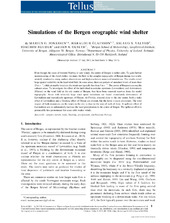Simulations of the Bergen orographic wind shelter
Jonassen, Marius Opsanger; Ólafsson, Haraldur; Valved, Aslaug Skålevik; Reuder, Joachim; Olseth, Jan Asle
Peer reviewed, Journal article
Published version

Åpne
Permanent lenke
https://hdl.handle.net/1956/11946Utgivelsesdato
2013-10-10Metadata
Vis full innførselSamlinger
- Geophysical Institute [1186]
Originalversjon
https://doi.org/10.3402/tellusa.v65i0.19206Sammendrag
Even though the coast of western Norway is very windy, the centre of Bergen is rather calm. To gain further understanding of this wind shelter, we study the flow in the complex topography of Bergen during two south-westerly windstorms using surface observations and high-resolution numerical simulations. The results reveal large spatial variability in the local wind field. In some areas, there are periods of sustained winds of more than 25m s−1, while at nearby locations the winds are typically less than 5m s−1. The centre of Bergen is among the calmest areas. To investigate the effect of the individual mountains upstream (Løvstakken) and downstream (Fløyen) on the wind field in the city centre of Bergen, they have been removed stepwise from the model topography. Areas with relatively large wind speed reductions are found immediately downstream of Løvstakken and immediately upstream of Fløyen. At Florida, situated close to the city centre, both a wake effect of Løvstakken and a blocking effect of Fløyen are evident, but the latter is more prominent. The total impact of both mountains on the winds in the city is close to the sum of each of them. A spillover effect of Løvstakken acts to substantially increase the local precipitation in the centre of Bergen. The spillover effect is presumably less pronounced for cases with weaker winds.
